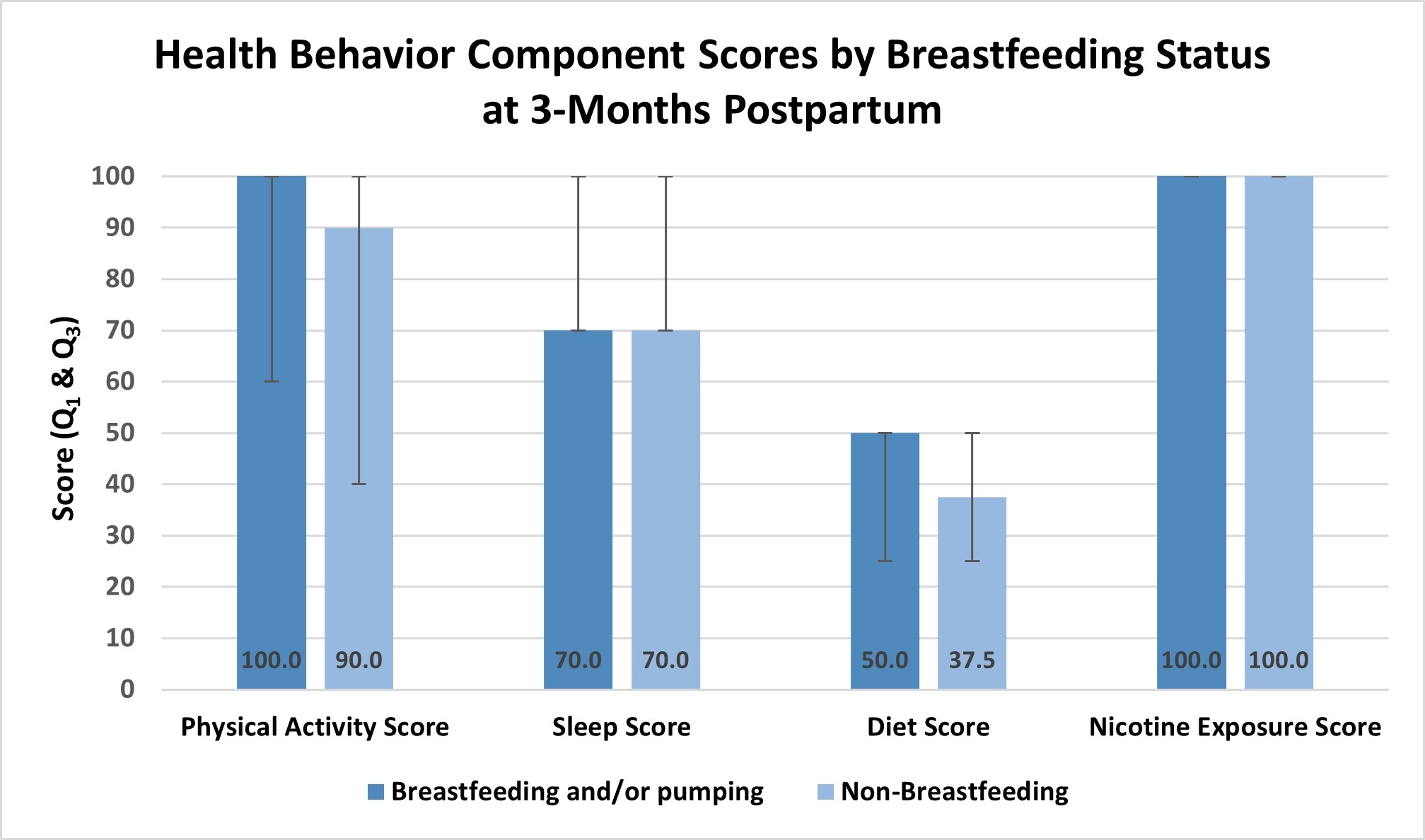Final ID: P1141
Breastfeeding and Postpartum Cardiovascular Health Behaviors at 3 Months in the Postpartum 24/7 Cohort
Abstract Body: Introduction: Breastfeeding promotes long-term cardiovascular health (CVH), but breastfeeding or using a breast pump as a primary infant feeding method may limit a mother’s capacity to engage in healthy CVH behaviors during the postpartum period. This study aimed to evaluate whether breastfeeding status defined as direct or indirect (pumping) at 3 months postpartum is associated with Life’s Essential 8 (LE8) CVH behaviors, including physical activity, sleep, diet, and avoidance of nicotine. Hypothesis: Those breastfeeding at 3 months postpartum will have less optimal physical activity, sleep, and diet scores, but better nicotine exposure scores. Methods: This is a secondary analysis of the Postpartum 24/7 cohort (n=50) at 3 months postpartum. Breastfeeding status was self-reported (yes/no). CVH behavior scores were assessed using the LE8 framework, which included device-based measures of physical activity (activPAL), self-reported sleep duration (Pittsburgh Sleep Quality Index), a diet assessment tool (Mediterranean Eating Pattern for Americans), and self-reported past and current nicotine exposure. Each CVH behavior was scored from 0 (least healthy) to 100 (most healthy) and an overall mean score was calculated by averaging scores across components. Multiple linear regression evaluated the association between breastfeeding and CVH behavior score, adjusting for pre-pregnancy BMI, race, and education. Mann-Whitney U tests evaluated differences by breastfeeding status and each CVH component. Results: At 3 months postpartum, 80% of the cohort (n=40) reported breastfeeding. Adjusted models showed that overall mean CVH behavior scores were similar and moderate (ranged 50-79) for both breastfeeding [69.3 ± 2.9 (SE)] and non-breastfeeding [68.1 ± 5.1] groups (p=.81). For specific CVH behaviors, nicotine exposure scores were highest while diet scores were lowest (see Figure). Breastfeeding and non-breastfeeding groups also had similar median scores for sleep and nicotine exposure. However, breastfeeding mothers had higher median scores for diet and physical activity that were possibly clinically meaningful though not statistically significant. Conclusion: Overall, breastfeeding status was not associated with CVH behavior scores at three months postpartum. As postpartum women had only moderate CVH behavior scores, this indicates a significant opportunity in the life course for promoting CVH behaviors, and particularly diet, regardless of breastfeeding.
More abstracts on this topic:
A Community Outreach Program Focused on Hypertension Awareness Reaches 600+ People in Rural Georgia and Works to Build the Next Generation of Biomedical Scientists
__PRESENT
Dent Elena, Ilatovskaya Daria, Pinkerton Brittany, Crider Emily, Ryan Michael, Sullivan Jennifer
Adverse Childhood Experiences (ACEs) and Cardiovascular Health: Future of Families and Child Wellbeing Study (FFCWS)__PRESENT
Pedamallu Havisha, Van Horn Linda, Stein James, Korcarz Claudia, Hansen Kristin, Mitchell Colter, Heard-garris Nia, Lloyd-jones Donald, Allen Norrina, Gauen Abigail, Ning Hongyan, Wilkins John, Goldman Noreen, Notterman Daniel, Hou Lifang, Zheng Yinan, Marma Amanda

